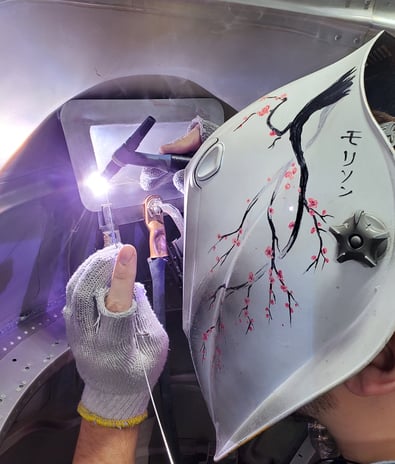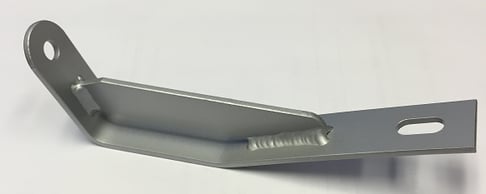Waterjet cutting of aerospace alloys is a very popular option because it is a cold process and does not have the disadvantages of hot processes such as laser cutting. Actually, many major aircraft manufacturers do not allow hot processes to cut rear net shape or net shape parts that are deemed structural or flight safety critical. The main reason is that hot process cutting can damage the base material by overheating the material and compromising the granular integrity of the alloy. When an aerospace alloy such as 6061-grade aluminum is cut using the laser process, the base material is damaged. The damaged area is referred to as the heat-affected zone (HAZ). Under magnification, the heat-affected zone will expose a multitude of undesirable indications such as Micro Cracks and Oxide Inclusions.
A typical result of a thermally cut alloy under magnification
Courtesy of https://www.researchgate.net/figure/Backscatter-micrograph-of-a-laser-drilling-induce-recast-oxide-inclusions-heat_fig7_303621008
Many aerospace components are integral items on structural aircraft frames for decades. Over time, the thermally induced, microscopic indications can begin to propagate through the material due to cyclical and static loads, this is commonly referred to as metal fatigue, and is the primary reason most structural aerospace alloys are best suited for waterjet cutting services.
At a recent MRO (Maintenance, Repair, and Overhaul) event, we were able to discuss common issues related to metal fatigue on aircraft components. Even though many of the components we reviewed were not safety critical, they still had a high-cost impact due to aircraft groundings for repair. Many non-critical aircraft components that were laser cut often show signs of metal fatigue after a few years of service. In the photos below you will see an APU access door from a commercial aircraft that began to show signs of cracking around the air intake flange. This flange was welded onto a duct, then heat treated and stress relieved. Finally, before assembly onto the aircraft, the duct was penetrant inspected for cracks and it did pass. However, about 10 years into service, cracks began to appear on the inside corners of the air intake flange. The entire fleet of aircraft was inspected and most of the air intake flanges exhibited the same stress cracks from metal fatigue. Laser cutting of these flanges was an approved method for this component, however, in the end, all of the doors had to be removed from the aircraft and sent out for certified repair. If these flanges were cut with the waterjet process, there is a good chance that the inside corner cracks would not have formed.
The air intake flange on this APU access door began to show signs of metal fatigue. Cracks began to form on the inside corners of this laser cut flange.
Photo Courtesy of Intelligent Cutting Solutions https://icscuts.com
This non-safety-critical aircraft component was laser cut. 10 years into flight service, this component had to be removed from the aircraft and go through a costly repair procedure

Photo Courtesy of Intelligent Cutting Solutions https://icscuts.com
Waterjet cutting of aerospace alloys is a cold process and there is no heat-affected zone (HAZ) after the completion of a cut. Another great attribute of waterjet cutting is that there is no thermal distortion. Besides flight safety, waterjet cutting offers additional benefits such as no secondary processing to remove the recast layer or straightening of the part. And another great reason for selecting waterjet is that it can cut almost any material.
Today’s waterjet machines are highly accurate and can cut within a tolerance of .003”. Many modern waterjet systems also employ taper compensation to eliminate tapered edges thus making net shape aerospace parts a reality. 5-Axis technology is now available which opens up an entirely new scope of possibilities when selecting the waterjet cutting process. Due to all of these technological advances most aerospace manufacturers turn to waterjet as the primary cutting method when making structural or flight safety critical components.
The components for this structural aircraft bracket were cut using the waterjet process. The aircraft manufacturer that incorporates this component into their aircraft, specifically states that hot-cutting processes are not allowed when making this part. Intelligent Cutting Solutions provided the waterjet cutting services for this bracket.

Photo Courtesy of Intelligent Cutting Solutions https://icscuts.com

Submit a comment